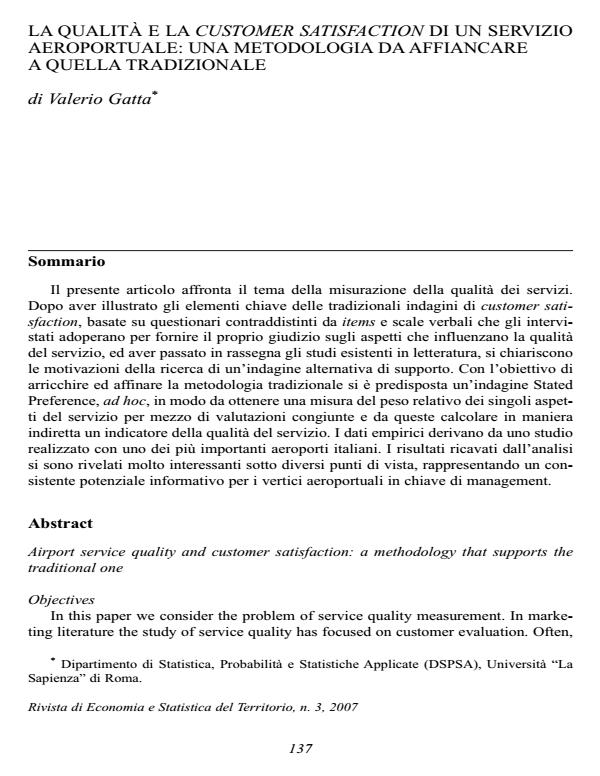La qualità e la customer satisfaction di un servizio aeroportuale: una metodologia da affiancare a quella tradizionale
Titolo Rivista RIVISTA DI ECONOMIA E STATISTICA DEL TERRITORIO
Autori/Curatori Valerio Gatta
Anno di pubblicazione 2008 Fascicolo 2007/3 Lingua Italiano
Numero pagine 23 P. 137-159 Dimensione file 338 KB
DOI
Il DOI è il codice a barre della proprietà intellettuale: per saperne di più
clicca qui
Qui sotto puoi vedere in anteprima la prima pagina di questo articolo.
Se questo articolo ti interessa, lo puoi acquistare (e scaricare in formato pdf) seguendo le facili indicazioni per acquistare il download credit. Acquista Download Credits per scaricare questo Articolo in formato PDF

FrancoAngeli è membro della Publishers International Linking Association, Inc (PILA)associazione indipendente e non profit per facilitare (attraverso i servizi tecnologici implementati da CrossRef.org) l’accesso degli studiosi ai contenuti digitali nelle pubblicazioni professionali e scientifiche
Airport service quality and customer satisfaction: a methodology that supports the traditional one (by Valerio Gatta). Objectives In this paper we consider the problem of service quality measurement. In marketing literature the study of service quality has focused on customer evaluation. Often, the global service quality index is simply computed as the average of the clients’ responses on the overall service evaluation and then, through the relationship among the latter and the judgments on each service dimension, the importance weights of the single service characteristics are calculated. Sometimes, the importance of each dimension is obtained by directly asking respondents to allocate a certain amount of points across the dimensions. It is to stress that these procedures may lead to partial or biased measures. With the aim to overcome this problem and to obtain a more precise satisfaction index, we consider a Stated Preference survey to be used in combination with the traditional customer satisfaction survey. Methods and Results Stated Preference methods refer to a family of techniques which foresees interviewing individuals concerning their preferences regarding a set of different options to estimate utility functions. In particular, we use a choice-based conjoint analysis which asks people to choose among hypothetical alternatives of the services. These options are described in terms of combinations of levels of the various airport features. By means of discrete choice models we analyze the data and we get the information required. We present findings from an empirical study. The data considered for this application is derived from a survey on airport customers conducted on a large Italian airport. Given our objective, in the actual study attribute levels are simply selected according to the items and verbal scales used in the general survey. We found that waiting time and airport services have the largest relative importance weights, while shops and duty free the smallest. Moreover, for each attribute, the effect on utility increases moving from the lowest category very poor to the highest category excellent, but this growth is not perfectly linear. Another aspect which is worth mentioning regards the substantial difference between the overall satisfaction index derived by linking up the two types of survey and the global judgment on the airport. Finally, through simulations we show the main elements in which airport management should concentrate their efforts. Conclusions The results obtained from the analysis are very interesting and potentially useful for airport marketing. By employing the methodology proposed, we are able to get the relative importance measures of the attributes, jointly evaluated, that is, based on an explicit trade-off between attributes, and through the latter information to calculate the service quality index.;
Valerio Gatta, La qualità e la customer satisfaction di un servizio aeroportuale: una metodologia da affiancare a quella tradizionale in "RIVISTA DI ECONOMIA E STATISTICA DEL TERRITORIO" 3/2007, pp 137-159, DOI: